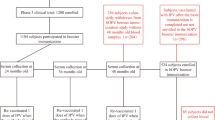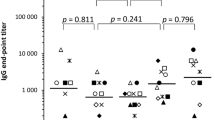Abstract
In order to evaluate the response to immunization of HIV-infected children we studied the humoral response to an enhanced potency inactivated poliovaccine (E-IPV) of 43 children born of HIV seropositive mothers. All these subjects have been followed for 32 (15–48) months in order to ascertain their infection status.
After a course of 2 doses of E-IPV, 88% of children had neutralizing antibody (n.a.) titers > 1:4 to the 3 poliovirus serotypes and 100% to at least 2 polio strains. No statistically significant differences both as rates of n.a. positive subjects and as antibody levels were found between HIV infected children and those who lost HIV antibodies. The poorest response was observed in subjects with full-blown immunodeficiency (CD4 < 1000/mm3, reduced response to PWM).
Sixteen children also received a booster dose of vaccine one year after the completion of the primary cycle. Infected and non-infected subjects responded to the same extent with high levels of n.a. to this immunization. Interestingly, the recall dose was also able to induce high n.a. titers in those HIV infected children who showed significant decreases of n.a. titers in the months following the end of the primary cycle.
Similar content being viewed by others
References
Bernstein L.J., Ochs H.D., Wedgwood R.J.et al. (1985): Defective humoral immunity in pediatric acquired immune deficiency syndrome. J. Pediatr. 107: 352–357.
Blanche S., LeDiest F., Fisher A., et al. (1986): Longitudinal study of 18 children with perinatal LAV/HTLV III infection: attempt at prognostic evaluation. J. Pediatr. 109: 965–970.
Borkowsky W. and Krasinski K. (1987): Residual cell-mediated immunity to recall antigens in pediatric AIDS-related disease. Pediatr. Res. 20: 292 A.
CDC (1986): Disseminated Mycobacterium bovis infection from BCG vaccination of a patient with acquired immunodeficiency syndrome. MMWR 34: 227–228.
CDC (1987): Classification system for immunodeficiency virus (HIV) infection in children under 13 years of age. MMWR 36: 225–235.
Fikrig S.M., Menez-Bautista R., Menikoff H., et al. (1987): Response of HIV infected children to pneumococcal vaccine. Pediatr. Res. 21: 311 A.
Immunization Practices Advisory Committee (1986): Immunization of children infected with human T-lymphotropic virus type III/lymphadenopathyassociated virus. MMWR 35: 595–598, 603–606.
Immunization Practices Advisory Committee (1989): General recommendations on immunization. MMWR 38: 205–227.
Krasinki K., Borkowsky W. (1987): Response to polio vaccination in children infected with human immunodeficiency virus. Pediatr. Res. 21: 328 A.
Mannucci P.M., Zanetti A.R., Gringeri A., et al. (1989): Long-term immunogenicity of a plasma derived hepatitis B vaccine in anti-HIV positive and anti-HIV negative hemophilics. Arch. Int. Med. 149: 1333–1337.
McLaughlin M., Thomas P., Onorato I., et al. (1988): Use of live virus vaccines in HIV-infected children: a retrospective survey. Pediatrics 82: 229–233.
Mendez H., Fikrig S., Deforest A., et al. (1988): Response to childhood immunizations in children with human immunodeficiency virus (HIV) infection. 4th International Conference on AIDS, Stockolm 1988. Abstract book, n° 5109.
Nelson K.E., Miotti P., Clements M.L., et al. (1988): The effect of a booster dose of influenza vaccine on antibody response of HIV-infected adults. 4th International Conference on AIDS, Stockolm 1988. Abstract book, n° 5111.
Nousbaum J.B., Garre M. and Boles J.M. (1988): Deux manifestation inhabituelles d'une infection par le virus LAV/HIV: BCGite et varicelle pulmonaire. Rev. Pneumol. Clin. 42: 310–311.
Onorato L.M, Markowitz L.E., Oxtoby M.J. (1988): Childhood immunization, vaccine-preventable diseases and infection with human immunodeficiency virus. Pediatr. Infect. Dis. 6:588–595.
Pizzo P.A. (1990): Pediatric AIDS: problems within problems. J. Infect. Dis. 161: 316–325.
Ragni M.V., Ruben F.L., Winkelstein A., et al. (1987): Antibody responses to immunization of patients with hemophilia with and without evidence of human immunodeficiency virus infection. J. Lab. Clin. Med. 109: 545–549.
Redfield R.R., Wright D.C., James W.D., et al. (1987): Disseminated vaccinia in a military recruit with human immunodeficiency virus (HIV) disease. N. Engl. J. Med. 316: 673–676.
Rhoads J.L. Birx D.L., Wright D.C., et al. (1987): Response to vaccination in HIV seropositive subjects. 3rd International Conference on AIDS, Washington 1987. Abstract WP. 110.
Special programme on AIDS and expanded programme on immunization (1987): Human immunodeficiency virus infection and routine childhood immunization. Geneva: World Health Organization, WHO/EPI/GAG/1987/WP 8 rev. 1.
VonReyn C.F., Clements C.J., Mann J.M., (1987): Human immunodeficiency virus infection and routine childhood immunization. Lancet, II: 669–672.
Author information
Authors and Affiliations
Rights and permissions
About this article
Cite this article
Barbi, M., Bardare, M., Luraschi, C. et al. Antibody response to inactivated polio vaccine (E-IPV) in children born to HIV positive mothers. Eur J Epidemiol 8, 211–216 (1992). https://doi.org/10.1007/BF00144802
Issue Date:
DOI: https://doi.org/10.1007/BF00144802




